Artificial Intelligence and Patentability: An Analysis

Artificial intelligence has been a trailblazer that has been bridging gaps and facilitating more efficient and expedient completion of tasks. New AI tools have been propping up every day, with innovation in the development of artificial intelligence showing no signs of stopping.
In India, patents are regulated by the Patents Act, 1970, which deal with “invention” and “patentability”. Many countries in the world have already started their journey toward legal implication of Artificial Intelligence as an inventor but, in India our legislature has failed to address the issue on an earlier date and thus India started its journey in 2017, when India’s Ministry of Commerce and Industry set up the 18-member Task Force on Artificial intelligence, with the mandate to advise inventors on the creation of a framework to promote and deploy Artificial intelligence, after taking all social and technological factors into account. After the Ministry of Commerce and Industry’s first step, the NITI Aayog, an Indian government think tank, published a discussion paper called, ‘India’s National Strategy for Artificial intelligence’ which discussed global developments in Artificial intelligence and the role of Artificial intelligence in the Indian society along with the challenges faced by it. However, it was highly concerning that such detailed discussion failed to address an essential aspect of AI, i.e., the legal implication of artificial intelligence.
With the development of Artificial intelligence, possibilities for new inventors have increased. This leads us to the most important question, whether Artificial intelligence should be considered as a legal entity with capabilities to hold property right or not. For that purpose, the nature and characteristics of artificial intelligence have to be analysed.
Artificial intelligence possesses the ability to communicate, to achieve the identified aims, creativity and to develop itself by cognitive process. Even though it has human replication, artificial intelligence fails to be sufficient to consider it as a legal personality. After going through the details of legal personality it would not be difficult to realize that there are entities other than human beings which are considered as legal personality, like corporations or companies.
Likewise in the Intellectual Property Rights, the patent framework grants the developer a limited number of imposing commercial models over the development. The owner of the patent rights is the inventor, and if the creator is not disclosed, the patent may be deemed invalid. The problem with creative AI is that if a machine creates anything as a free creation, can the machine be considered a “designer” and who will be granted patent rights for the AI creation.
Though, Section 6(a) of the Indian Patent Act,1970 allows patent application by any person claiming to be the true and first inventor of the invention, we see the court taking a liberal view in interpreting the term “person” like “anything under the sun that is made by man is patentable” in the decision of Diamond v. Chakrabarty, 447 U.S. (1980), which broadened the subject matter requirements for patents in the US. The goal of such a strategy was to ensure that the idea stays in the hands of the person who actually came up with it rather than a formal organisation like a company. To discuss the possibility of patentability of Artificial intelligence related invention, we need to understand the essence of AI related invention. AI related invention is a combination of several other inventions and not a single invention, which includes algorithms, mathematical formulae or methods and calculation or combination of both. With this clarification another thing comes into equation i.e., Section 3(k) of Indian Patent Law. According to Indian Patent Act, mathematical or business methods or a computer programs or algorithms are not eligible for patent protection. Since the law is not clear, the next reliable source of information is the guidelines issued by Indian Patent Office. The Indian Patent Office issued a few guidelines with respect to computer-related invention. The Patent Office’s are proactively taking steps to solving the issue because with every guideline there were new rules and requirement to be followed.
Again , as the accuracy and reliability of AI-generated data is still in a “grey area,” the courts have stated that “AI cannot substitute either the human intelligence or the humane element in the adjudicatory process, as best the tool could be utilized for a preliminary understanding or for preliminary research and nothing more.” These platforms in their current states are prone to bias. Any discovery by an AI, will be limited to the scope of a discovery alone and cannot in further terms, qualify as an invention to be granted with a patent protection. This is because of the unpredictability of such artificial intelligence. Creation of an AI is not patentable even as per the non-patentability requirements governed under section 3(a) of the Indian Patents Act, 1970. As per the said provision, any discovery which is contrary to the well-established principle of natural laws cannot be granted a patent protection. A patent protection for a robot being a mere application of mathematical formulae is not a patentable subject matter. Thus, granting a patent protection to robots would only cause confusion in the already existing legal system.
In the case of Ferid Allani v. Union of India, the Delhi High Court ruled that Computer related inventions are not barred from patentability, subject to investigation assessing the “technical effect” and “technical contribution” of the underlying invention. In this judgment the court rightly held that Section 3(k) put bar on computer programs per se and not on all invention based on computer program. This shows us that the Courts are facilitating the opening towards the uncharted territories.
In recent years, with the increase in developments of the AI field, the debate related to AI as IP rights holder has also increased. But the IP laws are failing to match the speed of these developments; hence uncertainty among the AI inventors has also increased. When we look at the precedents set, it is clear that the judgments are not in favour of granting IP rights to AI. These judgments revolve around the possibility of considering AI as a legal personality.
One such pertinent case is the AI DABUS case. In the case of Stephen L Thaler v. Comptroller General of Patents, Design and Trade Mark before the High Court of England and Wales, Special Patents Court, two patent applications were filed by Thaler before the United Kingdom Intellectual Property Office (IPO). The application specifies that Thaler was not an inventor, which is possible as Section 30[2] of the Patents Act, 1977 (‘the Act’) states that the right to apply for a patent is transferable. IPO subsequently notified Thaler to file the statement of inventor-ship and the right to grant patents pursuant to Section 13 of the Act which was Patent Form 7[3]. Thaler filed Patent Form 7 where he stated that the inventor is none other than an AI named Device for the Autonomous Bootstrapping of Unified Sentience (‘DABUS’) and since he is the owner of the AI is entitled to obtain the right to grant of the patents. The IPO held that no patent could be granted, and the same was upheld by the High Court as well.
The Court continuously relied upon the fact that Dabus cannot be granted the patent because it is not the ‘person’ without getting into the literal interpretation of what ‘person’ can constitute. Defining the limit of ‘person’ is something that seems to be left unaddressed. A person is natural as well as a legal person. Corporations form legal persons. Through the judgment the Court made itself very clear that the inventor cannot be any other than a person, therefore avoiding getting outside the bandwidth of the statutory scheme of the Act. One reason why it can be said to be a missed chance is because of their prior assumption of a person being a human and therefore, avoiding stretching the constitution of the term inventor.
But one problem with this judgment is that if AI cannot be registered as an inventor due to the lack of legal personality and humans cannot be registered since they are not directly involved, then the invention may not be patentable at all and it would be wrong because it will prevent inventors from investing money and time in AI technologies and as a result, it will prevent major breakthrough in important areas of science. This would more or less be hindering development of society.
In conclusion, it is seen that there is a huge gap between the current requirements and existing legal framework and with each passing day artificial intelligence creates new challenges for our legislatures. Since artificial intelligence is inevitable in future, it is necessary to match the pace to promote and define the limits of the artificial intelligence. Till then it is the duty of stakeholder like us to do our bit by voicing concerns at different stages as the need arises.

